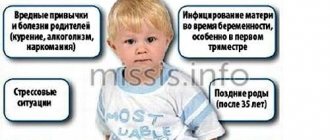What is agrammatism?
Every person learns speech thanks to the environment in which he finds himself.
This usually takes up to 4 years of a person’s life. There are errors in understanding and constructing sentences, which is normal. In subsequent years, the child only adjusts his speech and chooses his own style of communication. However, no significant errors are observed. What is agrammatism? This is a speech disorder that manifests itself in the lack of the correct ability to form and perceive sentences. Agrammatism can be recognized by the following signs:
- The person does not understand what is written.
- He is not able to retell what he read; he only singles out individual words.
- The person expresses his thoughts poorly.
- An individual’s speech lacks certain parts: prepositions, conjunctions, verbs.
In this case, you need to consult a doctor. Only he is able to identify the causes of speech impairment. It may not be agrammatism, in which case an accurate diagnosis is made and treatment is prescribed.
In people with this pathology, damage is observed in the Sylvian part of the brain. Agrammatism is used in relation to writing or reading. In adults, aphasia can be observed - the use in speech of words that are consonant in pronunciation, but not suitable in meaning.
go
Types of agrammatisms
Agrammatism is expressed in two types and forms:
- Impressive – disturbance of perception. The person partially or completely does not understand what is being said to him. This is caused by a change in the functioning of brain cells, which do not allow the transformation of sound signals into images and thoughts.
- Expressive – violation of expression. A person is not able to express his thought, to translate it into speech, words. Cases, declensions, prepositions are not used here, sentences are formed incorrectly or incompletely. It can be motor or sensory in nature.
- Sensory impairments lead to the inability to perceive and feel sound.
- Motor disorders are associated with a person’s inability to use the muscles of the tongue, larynx, and jaw to pronounce a particular word.
It is necessary to distinguish between learning disabilities and agrammatism. According to Libman, there are three degrees of agrammatism:
- A person is not able to compose a sentence or repeat it. Often replaces it with one word.
- A person uses sentence templates where changes in the form of words are not expressed, but he does not always manage to do this correctly.
- A person composes sentences syntactically incorrectly; errors mainly appear in declensions. This is possible with stuttering and tongue-tiedness.
go
Agrammatism in speech perception
The main symptoms of agrammatism in speech perception are [1]:
- difficulty perceiving sentences in which the semantic roles of the participants can be reversed (for example, a cat is chasing a dog
is understood worse than
a cat drinking milk
, because the situation “the cat drinks milk” is impossible); - difficulty perceiving sentences with word order that deviates from the basic one for a given language;
- difficulty perceiving sentences with a complex syntactic structure compared to simpler ones.
Symptoms of agrammatism associated with speech perception can be identified during an experiment in which the subject is asked to determine which of the demonstrated drawings corresponds to the sentence presented by the experimenter [1].
Symptoms of agrammatism
It is very easy to recognize agrammatism: a person uses speech incorrectly phonemically, grammatically or lexically. Typically, children who develop it do not write sentences until they are 3 or even 4 years old. Grammatical forms are used incorrectly. What are the symptoms of agrammatism?
- Difficulty understanding speech where the roles of the characters are reversed.
- Difficulty understanding sentences where words are rearranged into more complex forms.
- Difficulty understanding phrases with complex syntax rather than simple ones.
The presence of agrammatism is revealed by showing a series of pictures, among which it is necessary to choose the one that corresponds to the experimenter’s proposal.
Agrammatism is characterized by:
- Poverty and simplicity of composed sentences (or complete inability to form phrases).
- Low rate of speech, as the patient adapts to his pathology.
- Omission of some words: verbs, prepositions, articles.
- The inability to form sentences with unusual word order.
Many parents do not pay attention to the fact that their child is lagging behind in speech. It seems to them that if he makes sounds, then everything is fine. However, when it comes time to learn to write, then agrammatisms are noted. For example, “on the window”, “long tape”.
Prefixes and suffixes in words are learned by the age of 7-8 years. Speech is mainly formed by the age of 4. Next comes adjustment and strengthening. If parents ignore deviations, then agrammatism is noted by teachers who notice that the child is forming sentences incorrectly. By the age of 7-8 years, agrammatism clearly manifests itself.
go
Rehabilitation
In the domestic approach to the rehabilitation of patients with efferent motor aphasia (according to L. S. Tsvetkova), restoration of predicative speech and overcoming agrammatism is the goal at the third stage of rehabilitation training. If the patient has syntactic aphasia in isolation, restoration work can begin from this stage. The first goal is especially important with a severe degree of impairment, when verbal forms are practically not used in speech. Methods used:
- Isolating verbs from established series (we select a text that is well known to the patient, for example, a poem; we underline the verbs in it and discuss their meaning);
- Selection of verbs for objects (the patient is given a noun to which he must write as many suitable verbs as possible);
- Selection of inflections (link) and working out the meanings of morphemes in different situations (we show a picture and ask you to choose the correct form of the word from those proposed);
- Building a phrase structure using the chips method (you need to create an expanded phrase based on the picture, while the structural elements are associated with chips). At first, when constructing a phrase, the patient focuses as much as possible on the chips, gradually their role decreases. Thus, we help the patient express an idea that arises spontaneously.
The goal of the next stage of rehabilitation is the restoration of coherent phrasal speech. Here, techniques such as composing phrases from pictures, from a series of pictures, the dialogue method and the role-playing method are used.
Causes of agrammatism
Parents who observe agrammatism in their child are probably wondering: what are its causes? Several factors can be highlighted here.
The ability to perceive and reproduce speech depends on:
- age;
- education;
- psychological status;
- level of development;
- communication environment;
- physical condition;
- communication skills.
The causes of agrammatism can be:
- Organic changes in a part of the brain.
- Anatomical pathologies.
- Damage to the frontal lobe, Sylvian fissure, temporal lobe.
- Disturbances in the condition of nerve cells in the brain.
Total agrammatism is provoked by underdevelopment or improper functioning of auditory receptors. If they do not correctly or insufficiently pick up sound signals, then it is difficult for the child to understand the speech of others and then reproduce it. Thus, full-fledged speech can be formed when a person hears and perceives surrounding signals well and is immersed in them.
If agrammatism developed in an adult who already has communication skills, then this pathology cannot be explained by a disorder of sound receptors. Doctors associate this with neurological disorders.
Agrammatism is characteristic of people with:
- poor or complete lack of hearing;
- alalia;
- aphasia;
- developmental delay.
Examples of agrammatism
Readers of the medical dictionary slovmed.com will be interested in familiarizing themselves with various examples of agrammatism.
- “Here... surgery... here... emptiness... woke up...”
- “Beautiful girl”, “The cat... was carrying a chicken”, “The girl went home”, “My guests went.”
- “The cat drinks milk” is perceived better than “The cat is running away from the dog.”
- “Ag... Agr... Agra... Agram... Agrammatism.”
- “A girl is going to go for a walk on the street” (“The girl is going to go for a walk on the street”), “The girl is playing with the dog, and the sonic is on the bench” (“The girl is playing with the dog, and the elephant is on the bench”), “The boy is sitting on the bench and needles the balayka” (“A boy sits on a bench and plays a balalaika”).
- “Ride a horsecaf,” not “horses.”
- “A dove sits on a tree” (“A dove sits on a tree”).
Symptoms of agrammatism
In the presence of this disease, the symptoms directly depend on the extent to which the disease is manifested.
In particular, there are deficiencies in vocabulary and phonemic structure. Symptoms manifest themselves in the fact that the child begins to speak much later than usual. Thus, phrasal speech occurs after the age of three, or even when the child is already four years old. And in this case, it often contains agrammatisms, which are characterized by incorrect use of grammatical forms. Parents often do not attach importance to such speech disorders in a child, and they consider the main thing that the sounds themselves are pronounced correctly. They believe that after a certain time the child will be able to coordinate word combinations correctly. It is known that in this case the child successfully masters grammar corresponding to the level of study in the first grade, and the sound structure of words is also acquired. But, at the same time, there are difficulties in studying the morphological principles of writing. Feeling perplexed about this condition, parents eventually turn to a speech therapist or neurologist. Teachers immediately notice that the student is not able to cope with the rules of declension for cases, genders, and numbers. Such shortcomings are noticeable in the incorrect consistency of words and in the spelling of endings.
Examples of agrammatism in schoolchildren
Contrary to the rules of grammar, the child writes ungrammatically, for example, “on the table”, or “long road”. In accordance with age-related skills, children by the age of four should already be able to coordinate words correctly. It should be noted that at this age such speech errors cannot be considered the norm. When a child makes mistakes, such as “trees” or “near there”, then, of course, mandatory consultation with specialists is required. If we talk about the rules of word formation, where prefixes and suffixes are used, then children master such skills later, by about the age of eight. At this time, the student should already be able to normally coordinate words with each other, and easily form new ones. If this does not happen, then the specialist diagnoses agrammatism in children.
Upon admission to an educational institution, existing agrammatisms in school-age children are immediately identified. At the same time, a number of pronunciation defects are noted, the lexical and grammatical structure is unformed, and coherent speech and phonetic perception also do not correspond. A more pronounced manifestation of agrammatism is observed in seven- and eight-year-old children, because at this time schoolchildren are already mastering literacy and learning the rules of grammar. Prerequisites can be considered that the child has a poor vocabulary. According to research, this violation occurs precisely because of the poverty of the vocabulary, and incorrect understanding of the lexical meaning is also affected.
What is agrammatism and why does it occur?
Agrammatism (disgrammatism, paragrammatism) is a neuropsychological disorder characterized by a loss of the ability to analyze the grammatical structure of speech. Patients have problems with the perception and construction of sentences, they cannot express their thoughts correctly, and they have difficulties with reading and writing.
Similar disorders can occur with damage to the cerebral cortex in the frontal and temporal regions, general damage to the brain and disruption of the peripheral part of the auditory analyzer.
The causes of the disease may be:
- Nervous system diseases
- Trauma and damage to the brain, including intrauterine and perinatal.
Agrammatism also occurs with hearing loss and mental retardation.
Sometimes agrammatism accompanies speech disorders - aphasia, when the patient cannot express his thoughts in words and as a result of general underdevelopment of the mental system.
Distinction between the concepts of anterior and posterior agrammatism[ | ]
Violations of the grammatical design of speech can also occur with damage to the posterior parts of the brain, as part of acoustic-mnestic or semantic aphasia. In these cases they talk about posterior agrammatism. Although its symptoms are somewhat similar to syntactic aphasia, there are some significant differences. First of all, if in the case of anterior left-sided lesions changes affect syntagmatic connections, then in posterior agrammatism paradigmatic connections are disrupted, that is, it becomes difficult to select from a number of simultaneously processed objects [2].
The main defect in acoustic-mnestic aphasia is expressed by difficulties in selecting the sound form of a word, modality-specific processes of connection between the auditory and visual modalities are disrupted. Syntax, as a rule, is simplified, but complex constructions can also occur; speech understanding suffers more than production. Typical grammatical errors include word substitutions and difficulties in maintaining grammatical obligations[3], but the severity of syntactic violations varies greatly (up to absence) depending on the degree of damage. In the speech of patients with acoustic-mnestic aphasia there are fewer nouns and more verbs than with anterior agrammatism, that is, predication does not suffer. In addition, they do not have a connection between the number of errors and the degree of complexity of the construction; the patient can correctly use the indirect form of pronouns and at the same time make a mistake in the direct form of a noun - with syntactic aphasia this is impossible. All this speaks of the instability and secondary nature of the syntactic violation[2]. In semantic aphasia, simultaneous quasi-spatial analysis and synthesis [4] (simultaneous mental representation of several phenomena and assessment of quasi-spatial, that is, reflecting symbolic space, relationships between them) primarily suffers, which leads to a violation of the categorical meanings of words, as well as difficulties in understanding logical-grammatical designs.[1]. The most difficult thing for such patients is to understand reversible constructions (Girl saved by boy - Girl saved boy - Boy saved by girl, etc.). Feeling difficulty, patients can use certain compensatory techniques, simplifying or independently rearranging the structure of the sentence. The fact that they are able to easily make syntactic transformations already indicates the preservation of those operations that are impaired in patients with anterior agrammatism [2]. At the same time, grammatical errors do not occur in the construction of simple sentences.
Speech development of a child
A child’s speech development begins already from the first months of his life; by the age of 2.5–3 years, children learn most of the grammatical rules of oral speech, use declensions, conjugations of words, change them according to persons, numbers, and so on. Until the age of 5-6 years, the persistence of a certain agrammatism in a child is not considered a pathology; young children construct phrases in such a way as to convey information to the interlocutor as quickly as possible, without worrying about the correctness of the sentences.
There are also 3 levels of general speech underdevelopment in children.
Levels 1 and 2 – babbling and the beginnings of common speech. Such oral speech disorders can be associated both with a general developmental delay and with a violation of specific speech development.
RELATED MATERIALS: Idiocy as profound mental retardation
Level 3 underdevelopment – the presence of phrasal speech with elements of lexico-grammatical and phonetic-phonetic underdevelopment is characteristic of agrammatism.
Types of agrammatism
There are 2 main types of violation:
- Impressive agrammatism is a disturbance of perception. Due to changes in the cerebral cortex, patients cannot fully or partially perceive audible speech. This can be a complete misunderstanding of what is heard, or a partial one - for example, patients do not perceive complex sentences.
- Expressive agrammatism is a reproduction disorder. Patients understand speech, but cannot use prepositions, declensions, cases in conversation or writing, or form sentences incorrectly. There are sensory and motor expressive agrammatism. The sensory one is caused by a violation of the perception of the sound signal, and the motor one occurs when there is a violation of the control of the muscular apparatus of the larynx, vocal cords, jaws and tongue. Because of this, the patient cannot repeat and reproduce complex phrases or sounds.
There are also 3 degrees of severity of agrammatism:
- Inability to form a complete sentence, the agrammatician uses individual words instead.
- Rudimentary sentences are used - the words in the sentence may not be connected, but the patient can convey the general idea.
- Syntactic agrammatism – errors are observed in declensions, conjugations and in the use of complex sentences.
Agrammatism in speech production
Agrammatism in speech production is characterized [1]:
- simplicity and poverty of variety of syntactic structures of generated sentences (or lack of full-fledged sentences);
- omission of function words (articles, prepositions, auxiliary verbs) and pronouns. In languages that have inflection, inflections may be omitted [3] ;
- low speech rate. From the point of view of adaptation theory, this is due to the patient’s attempt to adapt to the disruption of his speech, which consists of slowing down the process of processing it;
- the difficulty of generating sentences with atypical word order.
Symptoms of aggramatism
If there are agrammatisms in speech, this can be either a sign of neurological disorders or the result of improper training and a low educational level, therefore it is necessary to check the person’s perception of speech and his ability to coherently repeat what he heard.
Symptoms of agramatism in children appear as early as 2-3 years. The child begins to speak later, uses simplified sentences, has difficulty understanding long phrases addressed to him and does not coordinate words with each other. By the age of 4, children should have developed the basic rules for composing words in a sentence and agreeing on them. Children with agrammatism have difficulty learning at school, they may have severe speech impairments, and due to difficulty in mastering a large amount of information, their academic performance deteriorates.
RELATED MATERIALS: Dysgraphic errors and ways to overcome them
In adults, agrammatism is characterized by the following symptoms:
- Simplicity and poverty of speech - patients have difficulty standing up and almost do not use detailed sentences in their oral and written speech, including additional and secondary members of the sentence.
- Slowness of speech perception and reproduction - since assimilation of information and its reproduction requires additional effort from patients, they need more time to understand, maintain a conversation or answer a question.
- Not using auxiliary parts of a sentence - typically “omitting” prepositions, auxiliary verbs and pronouns in speech.
- Difficulty in perceiving sentences with atypical construction, altered word order, or the use of metaphors, hyperboles, and so on.
Notes
- ↑ 1 2 3 4 5 Kolk, Herman.
Agrammatism // The MIT encyclopedia of communication disorders / Edited by Raymond D. Kent. - MIT Press, 2004. - P. 231-232. — 618 p. — ISBN 0-262-11278-7. - Altmann, Lori JP
Speech Production: Neurobiology // Encyclopaedia of Linguistics / Philipp Strazny, editor. - New York, Oxon: Fitzroy Dearborn, 2005. - P. 1026-1028. — ISBN 1-57958-391-1. - Radford, Andrew, et al.
Linguistics: an introduction. - Cambridge University Press, 1999. - P. 246. - 438 p.
Treatment
Agrammatism is a complex neurological disorder that requires complex treatment from a neurologist with mandatory sessions from a speech therapist, teacher and other specialists.
Overcoming agrammatism is a long process and treatment should begin when the first signs of pathology appear, because the sooner treatment is started, the greater the chances of recovery.
In treatment they use:
- Medicines - Piracetam, Nootropil, Cortexin, Cerebrolysin, Neuromultivit, Pantocalcin and so on.
- Physiotherapy - laser therapy, electromagnetic therapy, darsonval, microcurrents and so on.
- Speech therapy massage.
- Speech therapy exercises
- Psychologist consultations.
Agrammatism symptoms
All symptoms directly depend on the degree of manifestation of the disease, which are manifested in deficiencies in the phonemic structure of speech and vocabulary.
Symptoms of agrammatism manifest themselves in the fact that children begin to speak much later than expected. The emergence of phrasal speech occurs after 2-3, or even 4 years. The speech of children is often filled with agrammatisms, characterized by incorrect use of grammatical forms.
Often parents do not pay attention to disturbances in the child’s speech. They are reassured by the fact that sound pronunciation is normal, which means that over time, they believe, the child will learn to correctly coordinate word combinations. Such a child can successfully master the first grade program, which includes literacy, and also learn the sound structure of words. However, the child faces insurmountable difficulties in mastering the morphological principles of writing. And only after this, in a state of bewilderment, do parents turn to specialists (speech therapist, neurologist). The teacher actually immediately discovers that the child is unable to learn the rules for declension of words by gender, case, and number. This is noted in the incorrect agreement of words, as well as the spelling of word endings. The student writes ungrammatically (contrary to the rules of grammar). For example, “long tape”, “on the window”.
According to age-related skills, a child should be able to coordinate words correctly by the age of 4. And by this age, errors in speech are not the norm. If your child makes mistakes like “near the table” or “trees”, you need to get advice from specialists.
As for the rules of word formation using prefixes and suffixes, the child masters these skills much later, by the age of 7-8. At the age of 7-8 years, a student must agree words with each other, as well as form new words. If this does not happen, then agrammatism in children is diagnosed.
Agrammatisms in schoolchildren are detected immediately upon admission to an educational institution. Children have pronunciation defects, unformed lexical and grammatical structure, phonemic perception, and coherent speech.
Agrammatisms in children aged 7-8 years appear most clearly. It is during this period that children already master literacy and also begin to learn grammatical rules. The prerequisites for this are poor vocabulary. And as research shows, it is precisely because of the poverty of the vocabulary, as well as inaccuracies in understanding the lexical meaning of words, that this violation occurs.
EXPRESSIVE
EXPRESSIVE
\PHILOSOPHY\ ETHICS \ AESTHETICS\ PSYCHOLOGY\
\Poets (1) \Philosophy (1)\ Ethics (1)\ Aesthetics (1)\ Psychology (1)\ WRITER\
Calvin S. Hall, Gardner Lindsay THEORIES OF PERSONALITY (54) ...finally discuss research in the field of expressive behavior and individual cases - as that best reflects the main aspects of his theoretical views ... and Vernon, 1933) in the study of expressive behavior - one of the methods , preserving the structured individuality of each subject. Two other methods, structural analysis and content analysis, were used by Allport and ... A.F. Losev. HISTORY OF ANCIENT AESTHETICS. ARISTOTLE AND THE LATE CLASSICS (161) Expressive aesthetics 1. Ontology and aesthetics in the proper sense of the word. Aristotle's aesthetics from beginning to end is ontological aesthetics, then ... only expressive, only still expressive. b) There is nothing unexpected or surprising in such an Aristotelian term, and it constantly appears in Aristotle's expositions.
Expression (lat. expressio - expression):
Expression is a vivid manifestation of feelings, moods, thoughts. In a broad sense, it is the increased expressiveness of a work of art, achieved by the entire set of artistic means and depending on the manner of execution and the nature of the artist’s work; in a narrow sense - the manifestation of the artist’s temperament in his creative style, in the texture of the stroke, in the drawing, in the color and compositional solutions of the work of painting and sculpture.
Gene expression is the transformation of hereditary information from a gene into a functional product - RNA or protein.
Expressiveness
Expressiveness is the property of a certain set of linguistic units to convey the speaker’s subjective attitude towards the content or addressee of speech, as well as a set of qualities of speech or text based on such linguistic units.
Expressivity (genetics) is the degree to which the same allele of a certain gene is manifested in the phenotype of different individuals. Quantitative indicators of expressiveness are measured based on statistical data.
EXPRESSION, expressiveness; a bright, significant manifestation of feelings, moods, thoughts.
EXPRESSION - (Latin, from exprimere to express). Expressiveness: in painting, music, stage acting, etc. Dictionary of foreign words included in the Russian language. Chudinov A.N., 1910. EXPRESSION, expressiveness, predominantly. in stage game and painting. ...Dictionary of foreign words of the Russian language
expression - expressiveness; the power of manifestation of feelings and experiences. Expressive reactions are the external manifestation of a person’s emotions and feelings in facial expressions, pantomime, voice and gestures. Although expression in humans is genetically determined, .. Great Psychological Encyclopedia
S.I.Ozhegov, N.Yu.Shvedova. Explanatory Dictionary of the Russian Language (410) EXPRESSIVE, aya, oe;. veins vna (book). Containing expression, expressive. Expressive means of speech, || noun expressiveness, and, g., EXPRESSIONISM, a, m.
- expressive - embossed, picturesque, expressive, picturesque, figurative, convex, strong, eloquent, bright, colorful, colourful, lively, juicy Dictionary of Russian synonyms.
- EXPRESSIVE - [re], expressive, expressive; expressive, expressive, expressive (bookish). Expressive, expressive. - Expressive gesture. Expressive speech. Ushakov's explanatory dictionary. D.N.
— expressive — (from Latin expressio expression) expressive, capable of reflecting an emotional state. Brief psychological dictionary.
Rosa Ausländer (1) The expressive and at the same time lapidary poetry of Rosa Ausländer is close to the poetics of P. Celan, N. Sachs. Her legacy consists of more than twenty books of poetry, ... Carl Gustav Jung Psychological types (18) ... as if providing the object with its expressive function and thus depicting it - but not actively or intentionally, but in such a way that the object itself is depicted in ... Igor Semenovich Con Friendship - Ethical and psychological essay (2) ...systems, the importance of non-economic, especially expressive, functions of friendship increases. Cohen's typology of social structures raises a number of serious objections. First of all, it is formal, since it does not take into account either the method ... since it is hardly justified to consider the expressive functions of friendship as a late product of culture. Another question is the forms of this emotional support, which can also be provided through informal contacts, that is... Calvin S. Hall, Gardner Lindsay THEORIES OF PERSONALITY (55) His expressive movements do not seem dissociated and unrelated to each other; on the contrary, they are organized and well structured….that there is a congruence between expressive movements, on the one hand, and the attitudes, traits, values and other dispositions of the “inner” personality, on the other. A.F. Losev. HISTORY OF ANCIENT AESTHETICS. ARISTOTLE AND THE LATE CLASSICS (163) Finally, Aristotle’s expressive aesthetics does not end there. After all, even such a concept as “whatness” or “symbol” still continues to resonate... That is why Aristotle’s expressive aesthetics, which began with the elementary principles of potency and energy, eventually moved to such potency and... JAKOBSON The novel highlights the following functions: emotive (expressive), conative (=appellative), phatic, referential (communicative), metalinguistic, poetic. 1) The emotive function is focused on the addresser and aims at the direct expression of the speaker... emotive language, which primarily performs an expressive function, is usually closer to poetic language (which is aimed specifically at the sign as such). The transmitted information in most cases is not... JAKOBSON The novel identifies the following functions: emotive (expressive), conative (=appellative), phatic, referential (communicative), metalinguistic, poetic. 1) The emotive function is focused on the addresser and aims at the direct expression of the speaker... emotive language, which primarily performs an expressive function, is usually closer to poetic language (which is aimed specifically at the sign as such). The transmitted information in most cases is not ... Igor Semenovich Kon Friendship - Ethical-psychological essay (4) Emotionally expressive values, no matter how important they are for friendship, thus cease to be self-sufficient, but are included in the system of social relations that regulate ... social institution , in which emotionally expressive functions are subordinated to instrumental ones. As communal ties break down, friendship becomes a more or less temporary alliance based on a perceived community of interests. A.F. Losev. HISTORY OF ANCIENT AESTHETICS. ARISTOTLE AND THE LATE CLASSICS (162) It is easy to notice that all the previous expressive categories in Aristotle highlighted the emergence, formation and, in general, one or another functioning of an aesthetic object.... the main philosophical categories of Aristotle, which have an expressive character, we begin to notice that in the system Aristotle also has other categories, also associated with the moment of stopping... Igor Semenovich Kon Friendship - Ethical-psychological essay (3) ... rather calm and contemplative than expressive. The display of deep, intense intimacy is shocking to the Japanese. The right of an individual to the inviolability of her private life from strangers is lively discussed in modern Japanese... However, the expressive functions of friendship were not emphasized by culture, not because they did not exist, but because they were tacitly implied. Igor Kon Man in a changing world (7) ...are predominantly “instrumental”, and women’s ones are “expressive”. A man is a breadwinner, a “breadwinner”, and in the family he exercises general leadership and bears the main responsibility for disciplining children, while more ... found out that the maternal role was expressive in 48 of them, instrumental in 3 and mixed in 5. The paternal role turned out to be instrumental in 35, expressive in one... Psychology. (97) ...4) cathartic tests; 5) expressive tests; 6) impressive tests; 7) tests are additive. association tests. Many psychologists consider projective tests as especially valuable personality tests (personality: ... products of creativity - to the group of expressive tests. In the main version of the test, the subject is asked to draw a person on a piece of paper, and then a person of the opposite sex. Crowd. ... a specific community of people: occasional, conventional, expressive, active. If we talk about an occasional crowd, then the decisive factor in the formation of this type of community turns out to be a certain “opportunity”, a case, in connection with... An expressive crowd is traditionally imagined as such a large group, which is characterized by the fact that it manifests something in common, according to in essence, a single attitude towards what... Igor Kon Man in a Changing World (6) ... women's roles as instrumental and expressive first received a solid theoretical basis in the book of American sociologists Talcott Parsons and Robert Bales (Parsons, Bales, 1955) .... the individual is predominantly instrumental or predominantly expressive traits? and b) does he have relevant gender-specific interests? However, the ratio of specific criteria may not be the same. L. S. Vygotsky. Thinking and speech. The problem of speech development in the teachings of V. Stern ... distinguishes three roots (Wurzeln) of speech: expressive tendency, social tendency to communicate and “intentional”. Both first roots do not constitute a distinctive feature of human speech, they are also inherent in the rudiments “...to be placed on a par with expressive and communicative, tendencies that really stand at the beginning of the development of speech, and what, finally, Stern himself calls die “intentionale” Treibfeler des Sprachdranges ( ... SIGN ... object); semantic (image of the designated object); expressive (expressed through his feelings, etc.). 3. denotes a given object (an object designated by 3....and expresses conjugate semantic and expressive meanings. 3. can have a certain meaning without the presence of the corresponding object. Meaning 3. can be minimized in the presence of an objective meaning (proper names... A.F. Losev. HISTORY ANCIENT AESTHETICS: ARISTOTLE AND THE LATE CLASSICS (166) ...the problem of expression, that is, expressive aesthetics, has until now been completely ignored by Aristotle's researchers, or rather, it was not just ignored, but was presented in such an undifferentiated way and so ... there is an ontologically noological doctrine of expressive functions , probabilistic, or, generally speaking, topological functions of various kinds of communities in the form of works in which the constructive or decorative side is one... History and current state of rhetoric... for the emergence of a fundamentally new discipline of expressive stylistics. In fact, it is not very difficult to express an idea if its content has already taken shape in the intellectual (logical) sphere of consciousness... Expressive stylistics was the forerunner of the resurrection of old rhetoric. At the beginning of the 20th century. There are researchers who, based on the successes of modern psychology, are again trying... Igor Kon A man in a changing world (50) ... two aspects: ^the relationship between instrumental and expressive functions and 2) gender-specific strategies for disciplining children. In the first aspect, no special progress is noticeable. In the mid-20th century...children, in contrast to the predominantly expressive maternal role. Over the past 50 years, this polarization, like the polarization of masculinity and femininity in general, has noticeably weakened: from fathers... Psychology. (5) ... verbally sign information in its expressive form, as well as reading and counting, while the function of the right is to operate with images, orientation in space, distinguishing musical tones, melodies and ... the capabilities of the right hemisphere in relation to expressive speech are minimal), but these processes proceed differently in them. "Left-brain" thinking is discrete and analytical; with its help it is performed... A.F. Losev. HISTORY OF ANCIENT AESTHETICS. ARISTOTLE AND THE LATE CLASSICS (168) ...Aristotle's aesthetics, noological, cosmological, expressive and topological, for the first time give us the opportunity to be aware of the social historical place that Aristotle's aesthetics occupies in antiquity.... As for, further, Aristotle’s expressive aesthetics, here too, despite the consistently pursued ontologism, the practically creative moment in this aesthetics is crowned with such sections of being... A.F. Losev. HISTORY OF ANCIENT AESTHETICS. ARISTOTLE AND THE LATE CLASSIC (164) ...on what we called expressive aesthetics. Modern increased attention to the problems of aesthetic expressiveness has forced us to find this same theory of expression among ontological theories... that is, it is a kind of expressive aesthetics. This one circumstance alone brings Aristotle and modern aesthetics extremely close in many ways. But to bring this matter to the end, ... Igor Semenovich Kon Friendship - Ethical-psychological essay (20) ... it turns out that there is an opposition between the instrumental and expressive functions of communication and the relationship between friendship and love. There is hardly any need to explain the important practical significance of research into gender, age, social and... It is not without reason that the debate about the relationship between the expressive and instrumental values of friendship has been going on throughout the history of this category, and in the system of individual motivation these functions are constantly intertwined. The stereotype is social. ...southern Europeans are much more emotional, expressive and expansive than northern ones. The study asked students from 26 European countries to “...rate their compatriots from northern and southern Europe ... rated themselves as more expressive (compared to northerners)”486. At the same time, the stereotype is not only based on real facts, but represents a clearly realized personal... Igor Semenovich Kon Friendship - Ethical and Psychological Essay (16) ... are rather objective and instrumental than expressive. Girls' communication looks more passive, but more friendly and selective. Judging by psychological research, boys first make contacts...friendships are more focused on emotionally expressive values than more group and active youth friendships. How does the increased emotionality of a girl’s friendship affect its stability? Igor Kon A boy is a man's father (3) Goals and objectives of socialization ... and independence), and girls as expressive (emphasis on caring and obedience) is not entirely correct. A careful analysis of cross-cultural data from 30 societies showed that it is impossible to assess gender... Instrumental and expressive values are not so much poles as different aspects of the socialization process. The level of appropriate requirements for boys and girls varies in different societies... HABERMAS (Habermas) Jürgen (3) particularly excels in the expressive use of language.” Thus, universal pragmatics, from X.’s point of view, distinguishes the following modes of communication: cognitive, interactional and expressive; at the same time, they are thematized accordingly: propositional... L. S. Vygotsky. Thinking and speech. Genetic roots of thinking and speech (3) ...apparently egocentric speech, in addition to a purely expressive function and discharge function, in addition to the fact that it simply accompanies children's activity, very easily becomes thinking in the proper sense of this ... Likewise, speech that has an emotionally expressive function, speech is lyrical colored, possessing all the signs of speech, nevertheless can hardly be attributed to intellectual activity in ...
Her legacy consists of more than twenty books of poetry, ... Carl Gustav Jung Psychological types (18) ... as if providing the object with its expressive function and thus depicting it - but not actively or intentionally, but in such a way that the object itself is depicted in ... Igor Semenovich Con Friendship - Ethical and psychological essay (2) ...systems, the importance of non-economic, especially expressive, functions of friendship increases. Cohen's typology of social structures raises a number of serious objections. First of all, it is formal, since it does not take into account either the method ... since it is hardly justified to consider the expressive functions of friendship as a late product of culture. Another question is the forms of this emotional support, which can also be provided through informal contacts, that is... Calvin S. Hall, Gardner Lindsay THEORIES OF PERSONALITY (55) His expressive movements do not seem dissociated and unrelated to each other; on the contrary, they are organized and well structured….that there is a congruence between expressive movements, on the one hand, and the attitudes, traits, values and other dispositions of the “inner” personality, on the other. A.F. Losev. HISTORY OF ANCIENT AESTHETICS. ARISTOTLE AND THE LATE CLASSICS (163) Finally, Aristotle’s expressive aesthetics does not end there. After all, even such a concept as “whatness” or “symbol” still continues to resonate... That is why Aristotle’s expressive aesthetics, which began with the elementary principles of potency and energy, eventually moved to such potency and... JAKOBSON The novel highlights the following functions: emotive (expressive), conative (=appellative), phatic, referential (communicative), metalinguistic, poetic. 1) The emotive function is focused on the addresser and aims at the direct expression of the speaker... emotive language, which primarily performs an expressive function, is usually closer to poetic language (which is aimed specifically at the sign as such). The transmitted information in most cases is not... JAKOBSON The novel identifies the following functions: emotive (expressive), conative (=appellative), phatic, referential (communicative), metalinguistic, poetic. 1) The emotive function is focused on the addresser and aims at the direct expression of the speaker... emotive language, which primarily performs an expressive function, is usually closer to poetic language (which is aimed specifically at the sign as such). The transmitted information in most cases is not ... Igor Semenovich Kon Friendship - Ethical-psychological essay (4) Emotionally expressive values, no matter how important they are for friendship, thus cease to be self-sufficient, but are included in the system of social relations that regulate ... social institution , in which emotionally expressive functions are subordinated to instrumental ones. As communal ties break down, friendship becomes a more or less temporary alliance based on a perceived community of interests. A.F. Losev. HISTORY OF ANCIENT AESTHETICS. ARISTOTLE AND THE LATE CLASSICS (162) It is easy to notice that all the previous expressive categories in Aristotle highlighted the emergence, formation and, in general, one or another functioning of an aesthetic object.... the main philosophical categories of Aristotle, which have an expressive character, we begin to notice that in the system Aristotle also has other categories, also associated with the moment of stopping... Igor Semenovich Kon Friendship - Ethical-psychological essay (3) ... rather calm and contemplative than expressive. The display of deep, intense intimacy is shocking to the Japanese. The right of an individual to the inviolability of her private life from strangers is lively discussed in modern Japanese... However, the expressive functions of friendship were not emphasized by culture, not because they did not exist, but because they were tacitly implied. Igor Kon Man in a changing world (7) ...are predominantly “instrumental”, and women’s ones are “expressive”. A man is a breadwinner, a “breadwinner”, and in the family he exercises general leadership and bears the main responsibility for disciplining children, while more ... found out that the maternal role was expressive in 48 of them, instrumental in 3 and mixed in 5. The paternal role turned out to be instrumental in 35, expressive in one... Psychology. (97) ...4) cathartic tests; 5) expressive tests; 6) impressive tests; 7) tests are additive. association tests. Many psychologists consider projective tests as especially valuable personality tests (personality: ... products of creativity - to the group of expressive tests. In the main version of the test, the subject is asked to draw a person on a piece of paper, and then a person of the opposite sex. Crowd. ... a specific community of people: occasional, conventional, expressive, active. If we talk about an occasional crowd, then the decisive factor in the formation of this type of community turns out to be a certain “opportunity”, a case, in connection with... An expressive crowd is traditionally imagined as such a large group, which is characterized by the fact that it manifests something in common, according to in essence, a single attitude towards what... Igor Kon Man in a Changing World (6) ... women's roles as instrumental and expressive first received a solid theoretical basis in the book of American sociologists Talcott Parsons and Robert Bales (Parsons, Bales, 1955) .... the individual is predominantly instrumental or predominantly expressive traits? and b) does he have relevant gender-specific interests? However, the ratio of specific criteria may not be the same. L. S. Vygotsky. Thinking and speech. The problem of speech development in the teachings of V. Stern ... distinguishes three roots (Wurzeln) of speech: expressive tendency, social tendency to communicate and “intentional”. Both first roots do not constitute a distinctive feature of human speech, they are also inherent in the rudiments “...to be placed on a par with expressive and communicative, tendencies that really stand at the beginning of the development of speech, and what, finally, Stern himself calls die “intentionale” Treibfeler des Sprachdranges ( ... SIGN ... object); semantic (image of the designated object); expressive (expressed through his feelings, etc.). 3. denotes a given object (an object designated by 3....and expresses conjugate semantic and expressive meanings. 3. can have a certain meaning without the presence of the corresponding object. Meaning 3. can be minimized in the presence of an objective meaning (proper names... A.F. Losev. HISTORY ANCIENT AESTHETICS: ARISTOTLE AND THE LATE CLASSICS (166) ...the problem of expression, that is, expressive aesthetics, has until now been completely ignored by Aristotle's researchers, or rather, it was not just ignored, but was presented in such an undifferentiated way and so ... there is an ontologically noological doctrine of expressive functions , probabilistic, or, generally speaking, topological functions of various kinds of communities in the form of works in which the constructive or decorative side is one... History and current state of rhetoric... for the emergence of a fundamentally new discipline of expressive stylistics. In fact, it is not very difficult to express an idea if its content has already taken shape in the intellectual (logical) sphere of consciousness... Expressive stylistics was the forerunner of the resurrection of old rhetoric. At the beginning of the 20th century. There are researchers who, based on the successes of modern psychology, are again trying... Igor Kon A man in a changing world (50) ... two aspects: ^the relationship between instrumental and expressive functions and 2) gender-specific strategies for disciplining children. In the first aspect, no special progress is noticeable. In the mid-20th century...children, in contrast to the predominantly expressive maternal role. Over the past 50 years, this polarization, like the polarization of masculinity and femininity in general, has noticeably weakened: from fathers... Psychology. (5) ... verbally sign information in its expressive form, as well as reading and counting, while the function of the right is to operate with images, orientation in space, distinguishing musical tones, melodies and ... the capabilities of the right hemisphere in relation to expressive speech are minimal), but these processes proceed differently in them. "Left-brain" thinking is discrete and analytical; with its help it is performed... A.F. Losev. HISTORY OF ANCIENT AESTHETICS. ARISTOTLE AND THE LATE CLASSICS (168) ...Aristotle's aesthetics, noological, cosmological, expressive and topological, for the first time give us the opportunity to be aware of the social historical place that Aristotle's aesthetics occupies in antiquity.... As for, further, Aristotle’s expressive aesthetics, here too, despite the consistently pursued ontologism, the practically creative moment in this aesthetics is crowned with such sections of being... A.F. Losev. HISTORY OF ANCIENT AESTHETICS. ARISTOTLE AND THE LATE CLASSIC (164) ...on what we called expressive aesthetics. Modern increased attention to the problems of aesthetic expressiveness has forced us to find this same theory of expression among ontological theories... that is, it is a kind of expressive aesthetics. This one circumstance alone brings Aristotle and modern aesthetics extremely close in many ways. But to bring this matter to the end, ... Igor Semenovich Kon Friendship - Ethical-psychological essay (20) ... it turns out that there is an opposition between the instrumental and expressive functions of communication and the relationship between friendship and love. There is hardly any need to explain the important practical significance of research into gender, age, social and... It is not without reason that the debate about the relationship between the expressive and instrumental values of friendship has been going on throughout the history of this category, and in the system of individual motivation these functions are constantly intertwined. The stereotype is social. ...southern Europeans are much more emotional, expressive and expansive than northern ones. The study asked students from 26 European countries to “...rate their compatriots from northern and southern Europe ... rated themselves as more expressive (compared to northerners)”486. At the same time, the stereotype is not only based on real facts, but represents a clearly realized personal... Igor Semenovich Kon Friendship - Ethical and Psychological Essay (16) ... are rather objective and instrumental than expressive. Girls' communication looks more passive, but more friendly and selective. Judging by psychological research, boys first make contacts...friendships are more focused on emotionally expressive values than more group and active youth friendships. How does the increased emotionality of a girl’s friendship affect its stability? Igor Kon A boy is a man's father (3) Goals and objectives of socialization ... and independence), and girls as expressive (emphasis on caring and obedience) is not entirely correct. A careful analysis of cross-cultural data from 30 societies showed that it is impossible to assess gender... Instrumental and expressive values are not so much poles as different aspects of the socialization process. The level of appropriate requirements for boys and girls varies in different societies... HABERMAS (Habermas) Jürgen (3) particularly excels in the expressive use of language.” Thus, universal pragmatics, from X.’s point of view, distinguishes the following modes of communication: cognitive, interactional and expressive; at the same time, they are thematized accordingly: propositional... L. S. Vygotsky. Thinking and speech. Genetic roots of thinking and speech (3) ...apparently egocentric speech, in addition to a purely expressive function and discharge function, in addition to the fact that it simply accompanies children's activity, very easily becomes thinking in the proper sense of this ... Likewise, speech that has an emotionally expressive function, speech is lyrical colored, possessing all the signs of speech, nevertheless can hardly be attributed to intellectual activity in ...
Psychology. (1) ...various forms of agrammatism: 1) expressive agrammatism - characterized by errors in the grammatical construction of active speech; 2) impressive agrammatism - characterized by difficulties in understanding the meaning of grammatical structures, primarily those expressing relationships (...2) impulsive aggression; 3) expressive aggression. PHYSICAL AGGRESSION - Aggressive behavior using physical force directed against another subject or object. THOMAS AQUINAS ...primary cognitive images) - and about the “expressive spices” of the sensory order (after processing the initial images with the help of internal senses). To the inner feelings of F.A….spices” (abstracted from the sensual) and “expressive spices” of an intellectual order. Only thanks to this, from the potential intellect (into which the sensory image falls) does a concept arise. TIME in deconstruction...phenomenon” using the example of Husserl’s differentiation of expressive and indicative signs. Derrida shows that expressive signs, i.e. those in which meaning is expressed as if for the first time... Igor Semenovich Kon Friendship - Ethical-psychological essay (1) ...the distinction between expressive (emotional, affective) and instrumental (business, based on mutual benefit) friendship has become widespread in literature. The moral type of friendship, which Aristotle considered the only genuine one, falls out of the ... division or is silently identified with expressive relationships, where the individual personality principle is more fully expressed. The contrast between business, functional and emotional-personal relationships is certainly legitimate, and not only in... Psychology. (107) EXPRESSIVE - expressive, capable of reflecting an emotional state. EXPRESSION - expressiveness; the power of manifestation of feelings and experiences. Expressive reactions are the external manifestation of a person’s emotions and feelings - ... ZEVGMA ZEVGMA [from the Greek. zeugma ] - an expressive syntactic construction, which consists of the main word and homogeneous sentence members dependent on it, grammatically equivalent, but diverse in meaning, ... INTONATION INTONATION - rhythmic and melodic properties of oral speech, performing semantic and emotionally expressive functions. Mimic-gestural speech Mimic-gestural speech is a means of communication for the deaf with the help of gestures and facial expressions that are expressive and denoting in nature. Each concept is assigned to a specific gesture, but the generic relations between these concepts may be different than in normal... CONTEXT ...generated by the effect of the systematicity of the text as an expressively semantic integrity and consisting in the superadditivity of the meaning and meaning of the text in relation to the meaning and meaning of the sum of its linguistic components... Agrammatism With expressive agrammatism, errors occur in the grammatical construction of active speech. With impressive agrammatism, there is difficulty understanding the meaning of grammatical structures that previously express... Calvin S. Hall, Gardner Lindsay THEORIES OF PERSONALITY (10) ...mainly represent the verbalizations and expressive behavior of patients undergoing psychological treatment. Although Freud went through the school of exact scientific methods of the nineteenth century and built up a serious reputation as a physician... L. S. Vygotsky. Thinking and speech. The problem of the child’s speech and thinking in the teachings of J. Piaget (4) ...apparently, egocentric speech, in addition to its purely expressive and discharge function, in addition to the fact that it simply accompanies children’s activity, very easily becomes a means of thinking in the proper sense, ... Izard Carroll ... emotions identified three levels: neurophysiological, expressive, subjective. He gave a description of such fundamental emotions as: interest-excitement, joy, surprise, grief-suffering-depression, anger-disgust-contempt, fear-anxiety, shame-... LANGUAGE ...of society such functions as: 1) expressive; 2) significative; 3) cognitive; 4) information broadcast; 5) communicative. Analyticism of Ya. (discreteness of the meaning of its units and the possibility of their combinatorics according to ... S.I. Ozhegov, N.Yu. Shvedova. Explanatory Dictionary of the Russian Language (305) ... also music in the fast and expressive tempo of this dance, April samba, aya, oe. SAMBO, a, m. Sambo athlete. SAMBO, uncl., Wed. Coping behavior According to Maslow, it is opposed to expressive behavior. To identify individual coping strategies, the “Indicator of Stress Coping Strategies”, developed by D. Amirkhan, is used. Law of emotionality Speech also becomes emotional and expressive thanks to the expressive movements of the speaker, his voice. Law of emotionality Speech also becomes emotional and expressive thanks to the expressive movements of the speaker, his voice. Interhemispheric organization of mental processes ... right-handed people play a predominant role in expressive and impressive speech, in reading, writing, verbal memory and verbal thinking. The right hemisphere acts as the leading hemisphere for non-speech, for example, musical...
Tags EXPRESSIVE










